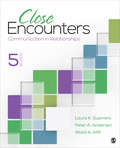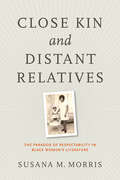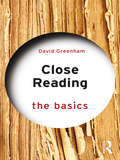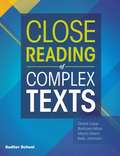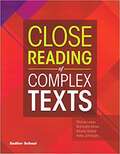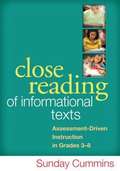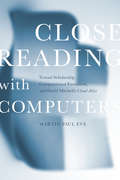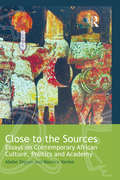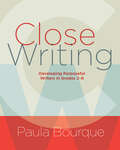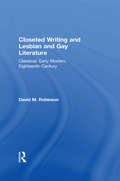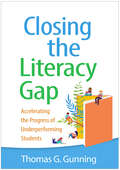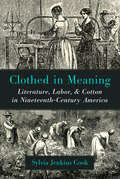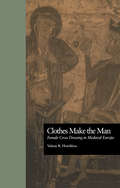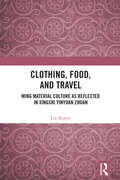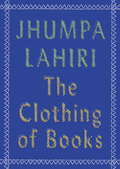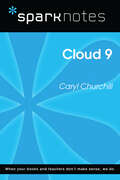- Table View
- List View
Close Encounters: Communication in Relationships
by Peter A. Andersen Laura K. Guerrero Walid AfifiClose Encounters: Communication in Relationships helps students learn about their own relationships with romantic partners, friends, and family members by focusing on issues that are central to describing and understanding close relationships. Best-selling authors Laura K. Guerrero, Peter A. Andersen, and Walid A. Afifi present research-based insights and content illustrated with engaging scenarios to show how state-of-the-art research and theory can be applied to specific issues within relationships. The updated Sixth Edition includes fresh content reflecting current research and trends in relationships, balanced with coverage of classic research, and continues to empower readers to be more critical consumers of information about relationships.
Close Encounters: Communication in Relationships
by Peter A. Andersen Laura K. Guerrero Walid AfifiClose Encounters: Communication in Relationships helps students learn about their own relationships with romantic partners, friends, and family members by focusing on issues that are central to describing and understanding close relationships. Best-selling authors Laura K. Guerrero, Peter A. Andersen, and Walid A. Afifi present research-based insights and content illustrated with engaging scenarios to show how state-of-the-art research and theory can be applied to specific issues within relationships. The updated Sixth Edition includes fresh content reflecting current research and trends in relationships, balanced with coverage of classic research, and continues to empower readers to be more critical consumers of information about relationships.
Close Encounters: Communication in Relationships
by Dr Laura K. Guerrero Dr Peter A. Andersen Dr Walid AfifiA relational approach to the study of interpersonal communication Close Encounters: Communication in Relationships, Fifth Edition helps students better understand their relationships with romantic partners, friends, and family members. Bestselling authors Laura K. Guerrero, Peter A. Andersen, and Walid A. Afifi offer research-based insights and content illustrated with engaging scenarios to show how state-of-the-art research and theory can be applied to specific issues within relationships—with a focus on issues that are central to describing and understanding close relationships. While maintaining the spotlight on communication, the authors also emphasize the interdisciplinary nature of the study of personal relationships by including research from such disciplines as social psychology and family studies. The book covers issues relevant to developing, maintaining, repairing, and ending relationships. Both the "bright" and "dark" sides of interpersonal communication within relationships are explored.
Close Encounters: Communication in Relationships
by Dr Laura K. Guerrero Dr Peter A. Andersen Dr Walid AfifiA relational approach to the study of interpersonal communication Close Encounters: Communication in Relationships, Fifth Edition helps students better understand their relationships with romantic partners, friends, and family members. Bestselling authors Laura K. Guerrero, Peter A. Andersen, and Walid A. Afifi offer research-based insights and content illustrated with engaging scenarios to show how state-of-the-art research and theory can be applied to specific issues within relationships—with a focus on issues that are central to describing and understanding close relationships. While maintaining the spotlight on communication, the authors also emphasize the interdisciplinary nature of the study of personal relationships by including research from such disciplines as social psychology and family studies. The book covers issues relevant to developing, maintaining, repairing, and ending relationships. Both the "bright" and "dark" sides of interpersonal communication within relationships are explored.
Close Kin and Distant Relatives: The Paradox of Respectability in Black Women's Literature
by Susana M. MorrisThe "black family" in the United States and the Caribbean often holds contradictory and competing meanings in public discourse: on the one hand, it is a site of love, strength, and support; on the other hand, it is a site of pathology, brokenness, and dysfunction that has frequently called forth an emphasis on conventional respectability if stability and social approval are to be achieved. Looking at the ways in which contemporary African American and black Caribbean women writers conceptualize the black family, Susana Morris finds a discernible tradition that challenges the politics of respectability by arguing that it obfuscates the problematic nature of conventional understandings of family and has damaging effects as a survival strategy for blacks. The author draws on African American studies, black feminist theory, cultural studies, and women’s studies to examine the work of Paule Marshall, Jamaica Kincaid, Edwidge Danticat, and Sapphire, showing how their novels engage the connection between respectability and ambivalence. These writers advocate instead for a transgressive understanding of affinity and propose an ethic of community support and accountability that calls for mutual affection, affirmation, loyalty, and respect. At the core of these transgressive family systems, Morris reveals, is a connection to African diasporic cultural rites such as dance, storytelling, and music that help the fictional characters to establish familial connections.
Close Reading: The Basics (The Basics)
by David GreenhamClose reading is the most essential skill that literature students continue to develop across the full length of their studies. This book is the ideal guide to the practice, providing a methodology that can be used for poetry, novels, drama, and beyond. Using classic works of literature, such as Hamlet and The Great Gatsby as case studies, David Greenham presents a unique, contextual approach to close reading, while addressing key questions such as: What is close reading? What is the importance of the relationships between words? How can close reading enhance reading pleasure? Is there a method of close reading that works for all literary genres? How can close reading unlock complexity? How does the practice of close reading relate to other theoretical and critical approaches? Close Reading: The Basics is formulated to bring together reading pleasure and analytic techniques that will engage the student of literature and enhance their reading experience.
Close Reading in Elementary School: Bringing Readers and Texts Together
by Diana Sisson Betsy SissonMany literacy experts believe close reading has the power to create strong, independent readers, but what does that really mean, and how does it work in the classroom? This book is your must-have guide to getting started! It provides step-by-step strategies and scaffolds for teaching close reading and improving students’ comprehension of complex texts. You will learn how to teach close reading based on text type, how to accelerate learning through increasingly challenging texts in both print and digital media, how to use close reading as a springboard for close talks and close writes, and how to support your students to move forward confidently with a repertoire of tools to employ as they navigate complex text in their daily lives.Special Features: A clear explanation of what text complexity really means and how it varies by student An easy-to-use framework for creating a close reading lesson that builds student reading stamina Scaffolds to help students at all ability levels to do a close reading Close reading strategies for a variety of literary and informational genres Ideas for strengthening reading through targeting comprehension skills, including analyzing text structure and evaluating arguments Suggestions for helping students read with increasing levels of rigor Techniques for how to lessen student technology distractions and dig deeper into digital text Guidelines and procedures for close talks – purposeful, focused discussions about text Procedures for close writes that vary based on genre and student ability level Recommendations to ensure students have the close reading skills to be effective readers in and out of the classroom In addition, each chapter includes study guide questions to help you apply the ideas in the book to your own classroom. With this practical book, you will have all the tools you need to make close reading a reality!
Close Reading of Complex Texts
by Diane Lapp Barbara Moss Maria GrantClose Reading of Complex Texts, Grade 5, is a consumable Student Worktext with texts sets and formative assessments included.
Close Reading of Complex Texts
by Diane Lapp Barbara Moss Maria Grant Kelly JohnsonThis book provides the text sets and text-dependent questions you need to support instruction in the close reading and critical analysis of complex texts. You’ll find: Expertly curated text sets for a variety of disciplines to save you time in your preparation; Meaningful Focus Questions to connect texts and build students’ knowledge on each topic; Carefully crafted, Text-Dependent Questions to help students closely and critically read increasingly complex texts.
Close Reading of Complex Texts, Grade 7
by Diane Lapp Barbara Moss Maria Grant Kelly JohnsonClose reading is reading a text more than once in order to understand its deeper meaning. You uncover the reasons authors choose particular words and phrases, include literary elements and plot points, or organize the text or introduce information a particular way. You draw connections between the ideas and details in the texts--and from specific texts to bigger topics. You will read the texts in Close Reading of Complex Texts three times, with a different purpose each time. 1st READ - Determine what the text is about. 2nd READ - Focus on the language used by the author and the structure of the text. 3rd READ - Look for meaning by making inferences.
Close Reading of Informational Texts
by Sunday CumminsThis essential book provides a roadmap for instruction and assessment of close reading skills in grades 3-8. To engage deeply with informational texts--a key requirement of the Common Core standards--students need to determine what details are important, how they fit together to convey a central idea, and how to synthesize information from multiple sources. They also need to understand the unique demands of different text features and structures. Presenting effective instructional strategies that teachers can tailor to their own classrooms, the book includes lesson plans, vignettes, and examples of student work, plus a Study Guide with professional learning activities and discussion questions.
Close Reading the Anthropocene
by Helena FederReading poetry and prose, images and art, literary and critical theory, science and cultural studies, Close Reading the Anthropocene explores the question of meaning, its importance and immanent potential for loss, in the new geological epoch of the Anthropocene. Both close reading and scientific ecology prioritize slowing down and looking around to apprehend similarities and differences, to recognize and value interconnections. Here "close" suggests careful attention to both the reading subject and read "object." Moving between places, rocks, plants, animals, atmosphere, and eclipses, this interdisciplinary edited collection grounds the complex relations between text and world in the environmental humanities. The volume’s wide-ranging chapters are critical, often polemical, engagements with the question of the Anthropocene and the changing conversation around reading, interpretation, and textuality. They exemplify a range of work from across the globe and will be of great interest to scholars and students of the environmental humanities, ecocriticism, and literary studies.
Close Reading with Computers: Textual Scholarship, Computational Formalism, and David Mitchell's <i>Cloud Atlas</i>
by Martin Paul EveMost contemporary digital studies are interested in distant-reading paradigms for large-scale literary history. This book asks what happens when such telescopic techniques function as a microscope instead. The first monograph to bring a range of computational methods to bear on a single novel in a sustained fashion, it focuses on the award-winning and genre-bending Cloud Atlas (2004). Published in two very different versions worldwide without anyone taking much notice, David Mitchell's novel is ideal fodder for a textual-genetic publishing history, reflections on micro-tectonic shifts in language by authors who move between genres, and explorations of how we imagine people wrote in bygone eras. Though Close Reading with Computers focuses on but one novel, it has a crucial exemplary function: author Martin Paul Eve demonstrates a set of methods and provides open-source software tools that others can use in their own literary-critical practices. In this way, the project serves as a bridge between users of digital methods and those engaged in more traditional literary-critical endeavors.
Close to the Sources: Essays on Contemporary African Culture, Politics and Academy (Routledge African Studies)
by Abebe Zegeye Maurice VambeEuropean and African works have found it difficult to move past the image of Africa as a place of exotica and relentless brutality. This book explores the status and critical relationship between politics, culture, literary creativity, criticism, education and publishing in the context of promoting Africa’s indigenous knowledge, and seeks to recover some of the sites where Africans continue to elaborate conflicting politics of self-affirmations. It both acknowledges and steps outside the protocols of analysis informed by nationalism, differentiating the forms that postcolonial theories have taken, and arguing for a selective appropriation of theory that emerges from Africa’s lived experiences.
Close Writing: Developing Purposeful Writers in Grades 2-6
by Paula BourqueHow closely do your students read their writing? What are the implications for those who do and those who don't? During her work in classrooms, literacy coach Paula Bourque noticed that students who read their own writing closely are engaged in their work, write fluently, are able to produce lengthy drafts, and incorporate teaching points from mini-lessons into the day's writing. In this comprehensive book, Paula shows you that no matter what structures or lessons you use in your writing classroom, the strategies in Close Writing will help you make these better by creating student writers who are more aware of what effective writing looks like, who care about what they write, and who take ownership and responsibility for their growth as writers. Paula argues that a key element in close writing is learning to look and looking to learn by closely reading our own writing. Instead of focusing on the mechanics of their writing, she encourages students to read their words for understanding, clarity, and the effect they will have on an audience. She urges them to recognize their habits and their approaches to writing and to build upon them.Close Writing is based on research and methods that are reliable and valid best practices, but it will not prescribe lessons or structures. It gives you a peek inside classrooms where teachers just like you are working with budding authors just like yours. Paula also provides considerations for ELL writers, as well as a section of interviews with authors. She shares an extensive reference/resource guide, and a companion website with students' work samples, reproducibles and templates, and videos of classroom writing lessons round out this must-have resource.
The Closet: The Eighteenth-Century Architecture of Intimacy
by Danielle BobkerA literary and cultural history of the intimate space of the eighteenth-century closet—and how it fired the imaginations of Pepys, Sterne, Swift, and so many other writers Long before it was a hidden storage space or a metaphor for queer and trans shame, the closet was one of the most charged settings in English architecture. This private room provided seclusion for reading, writing, praying, dressing, and collecting—and for talking in select company. In their closets, kings and duchesses shared secrets with favorites, midwives and apothecaries dispensed remedies, and newly wealthy men and women expanded their social networks. In The Closet, Danielle Bobker presents a literary and cultural history of these sites of extrafamilial intimacy, revealing how, as they proliferated both in buildings and in books, closets also became powerful symbols of the unstable virtual intimacy of the first mass-medium of print. <P><P>Focused on the connections between status-conscious—and often awkward—interpersonal dynamics and an increasingly inclusive social and media landscape, The Closet examines dozens of historical and fictional encounters taking place in the various iterations of this room: courtly closets, bathing closets, prayer closets, privies, and the "moving closet" of the coach, among many others. In the process, the book conjures the intimate lives of well-known figures such as Samuel Pepys and Laurence Sterne, as well as less familiar ones such as Miss Hobart, a maid of honor at the Restoration court, and Lady Anne Acheson, Swift's patroness. <P><P>Turning finally to queer theory, The Closet discovers uncanny echoes of the eighteenth-century language of the closet in twenty-first-century coming-out narratives.Featuring more than thirty illustrations, The Closet offers a richly detailed and compelling account of an eighteenth-century setting and symbol of intimacy that continues to resonate today.
Closet Devotions
by Richard RambussReligion and sex, body and soul, sacred and profane: In Closet Devotions, Richard Rambuss traces the relays between these cultural formations by examining the issue of "sacred eroticism," the literary or artistic expression of devotional feelings in erotic terms that has repeatedly occurred over the centuries. Rather than dismissing such expression as mere convention, Rambuss takes it seriously as a form of erotic discourse, one that gives voice to desires that, outside the sphere of sacred rapture, would otherwise be deemed taboo.Through startling rereadings of works ranging from the devotional verse of the metaphysical poets (Donne, Herbert, Crashaw, and Traherne) to photographer Andres Serrano's controversial "Piss Christ," from Renaissance religious iconography to contemporary gay porn, Rambuss uncovers the highly charged erotic imagery that suffuses religious devotional art and literature. And he explores one of Christian culture's most guarded (and literal) closets--the prayer closet itself, a privileged space where the vectors of same-sex desire can travel privately between the worshiper and his or her God.Elegantly written and theoretically astute, Closet Devotions illuminates the ways in which sacred Christian devotion is homoeroticized, a phenomenon that until now has gone unexplored in current scholarship on religion, the body, and its passions. This book will attract readers across a wide array of disciplines, including gay and lesbian studies, literary theory and criticism, Renaissance studies, and religion.
Closeted Writing and Lesbian and Gay Literature: Classical, Early Modern, Eighteenth-Century
by David M. RobinsonArguing for renewed attention to covert same-sex-oriented writing (and to authorial intention more generally), this study explores the representation of female and male homosexuality in late sixteenth- through mid-eighteenth-century British and French literature. The author also uncovers and analyzes long-term continuities in the representation of same-sex love, sex, and desire between the classical, early modern, eighteenth-century, and even modern periods. Among the seventeenth- and eighteenth-century authors and texts examined here are Mme de Murat, Les Memoires De Madame La Comtesse De M*** (1697); John Cleland, Memoirs of a Woman of Pleasure (1748-49); Tobias Smollett, The Adventures of Roderick Random (1748); Nicolas Chorier and Jean Nicolas, L'Academie des dames (1680); Delarivier Manley, The New Atalantis (1709); and Isaac de Benserade, Iphis et Iante (1637). Classical texts brought into the discussion include Juvenal's Satires, Lucian's Erotes, and, most importantly, Ovid's Metamorphoses. Casting its net broadly yet exploring deeply-poems, plays, novels, and more; from the serious to the satiric, the polite to the pornographic; well-known and little-known; written in English, French, and Latin; published in early modern and eighteenth-century Britain and France; plus key classical texts-this study engages with the historiography of sexuality as a whole.
Closing the Literacy Gap: Accelerating the Progress of Underperforming Students
by Thomas G. GunningPacked with practical tools, this book provides K–6 educators with a research-based framework for accelerating the reading and writing growth of underperforming students. Strategies and resources are included for building foundational skills, comprehension, and vocabulary; engaging students with independent reading and periodicals; developing writing; and implementing tutoring and other extra supports. The book gives special attention to helping those most affected by the literacy gap--Black and Latinx students, students living in poverty, and students with reading disabilities. It describes dozens of high-quality intervention programs, assessments, activities, and materials, many of which can be accessed for free at the companion website. Reproducible forms and handouts can be downloaded and printed in a convenient 8 1/2" x 11" size.
The Closure of Space in Roman Poetics
by Victoria RimellThis ambitious book investigates a major yet underexplored nexus of themes in Roman cultural history: the evolving tropes of enclosure, retreat and compressed space within expanding, potentially borderless empire. In Roman writers' exploration of real and symbolic enclosures - caves, corners, villas, bathhouses, the 'prison' of the human body itself - we see the aesthetic, philosophical and political intersecting in fascinating ways, as the machine of empire is recast in tighter and tighter shapes. Victoria Rimell brings ideas and methods from literary theory, cultural studies and philosophy to bear on an extraordinary range of ancient texts rarely studied in juxtaposition, from Horace's Odes, Virgil's Aeneid and Ovid's Ibis, to Seneca's Letters, Statius' Achilleid and Tacitus' Annals. A series of epilogues puts these texts in conceptual dialogue with our own contemporary art world, and emphasizes the role Rome's imagination has played in the history of Western thinking about space, security and dwelling.
Clothed in Meaning: Literature, Labor, and Cotton in Nineteenth-Century America (Class : Culture)
by Sylvia Jenkins CookThe rise of both the empire of cotton and the empire of fashion in the nineteenth century brought new opportunities for sartorial self-expression to millions of ordinary people who could now afford to dress in style and assert their physical presence. Millions of laborers toiling in cotton fields and producing cotton cloth in industrial mills faced a brutal reality of exploitation, servitude, and regimentation—yet they also had a profound desire to express their selfhood. Another transformative force of this era—the rise of literary publication and the radical extension of literacy to the working class—opened an avenue for them to do so. Cloth and clothing provide potent tropes not only for physical but also for intellectual forms of self-expression. Drawing on sources ranging from fugitive slave narratives, newspapers, manifestos, and mill workers’ magazines to fiction, poetry, and autobiographies, Clothed in Meaning examines the significant part played by mill workers and formerly enslaved people, many of whom still worked picking cotton, in this revolution of literary self-expression. They created a new literature from their palpable daily intimacy with cotton, cloth, and clothing, as well as from their encounters with grimly innovative modes of work. In the materials of their labor they discovered vivid tropes for formulating their ideas and an exotic and expert language for articulating them. The harsh conditions of their work helped foster in their writing a trenchant irony toward the demeaning reduction of human beings to “hands” whose minds were unworthy of interest. Ultimately, Clothed in Meaning provides an essential examination of the intimate connections between oppression and luxury as recorded in the many different voices of nineteenth-century labor.
Clothes Make the Man: Female Cross Dressing in Medieval Europe (New Middle Ages)
by Valerie R. HotchkissIn this book, the author explores medieval society's fascination with the cross-dressed woman. The author examines a wide variety of religious, literary, and historical sources, which record interpretations of sartorial attempts to overcome gender hierarchy and also illustrate, mainly through the device of inversion, a remarkably sustained desire to examine and reexamine the nature of social gender identities.
Clothing, Food, and Travel: Ming Material Culture as Reflected in Xingshi Yinyuan Zhuan
by Liu XiaoyiThis book explores the material and cultural history of the Ming Dynasty based on the Chinese magnum opus Xingshi Yinyuan Zhuan (literally, The Story of a Marital Fate to Awaken the World), written under the pseudonym of the seventeenth-century writer Xizhou Sheng.The novel weaves into its narrative, through the characters' personalities and the events it illustrates, important details of Ming material life. Through the literary snapshot of the Ming material culture as reflected in Xingshi Yinyuan Zhuan, this work investigates the practices and customs of clothing, food, and travel, three of the "four major concerns of the people's livelihoods," known as yishizhuxing in Chinese. While frequenting economic dimensions and probing the impact that Ming politics had on the ethos and social economy of the period, it sheds significant light on folk customs, legal and religious practices, and the status of women, among other issues. This work aims to enrich the current Western scholarship, done primarily by Timothy Brook, Craig Clunas, and Glen Dudbridge, on Ming material culture. The book will be of great value to students and scholars of East Asian Studies, Chinese literature, and those interested in the history of material culture in general.
The Clothing of Books
by Jhumpa LahiriHow do you clothe a book? In this deeply personal reflection, Pulitzer Prize-winning author Jhumpa Lahiri explores the art of the book jacket from the perspectives of both reader and writer. Probing the complex relationships between text and image, author and designer, and art and commerce, Lahiri delves into the role of the uniform; explains what book jackets and design have come to mean to her; and how, sometimes, "the covers become a part of me."
Cloud 9 (SparkNotes Literature Guide Series)
by SparkNotesCloud 9 (SparkNotes Literature Guide) by Caryl Churchill Making the reading experience fun! Created by Harvard students for students everywhere, SparkNotes is a new breed of study guide: smarter, better, faster.Geared to what today's students need to know, SparkNotes provides:*chapter-by-chapter analysis *explanations of key themes, motifs, and symbols *a review quiz and essay topics Lively and accessible, these guides are perfect for late-night studying and writing papers.

